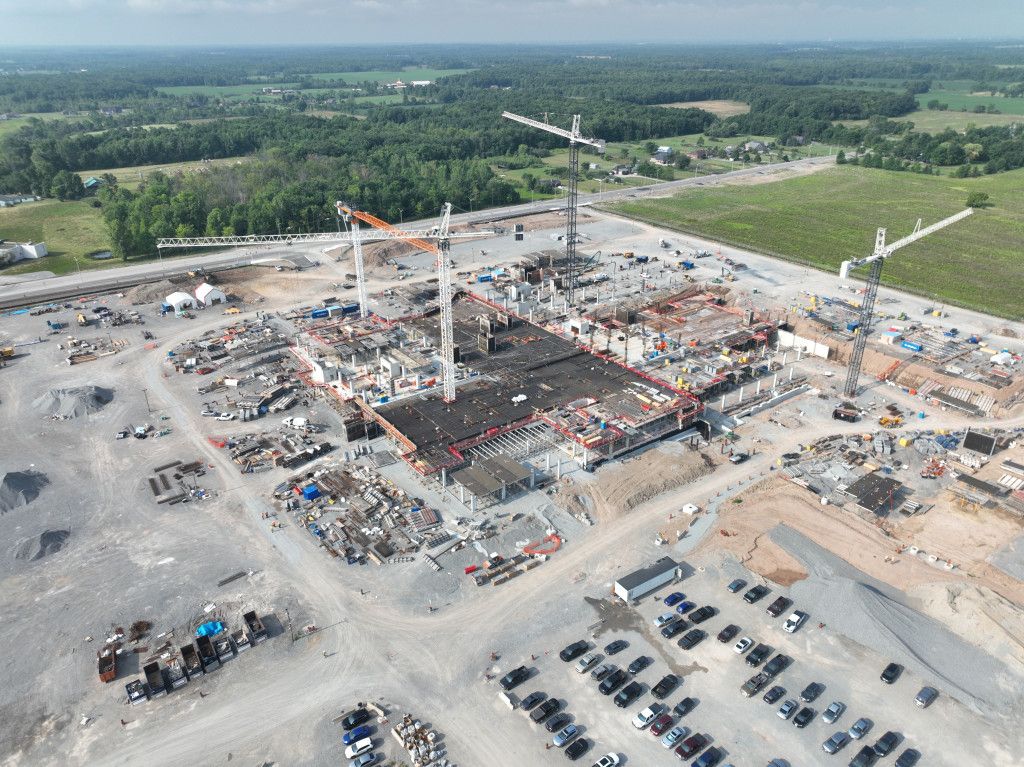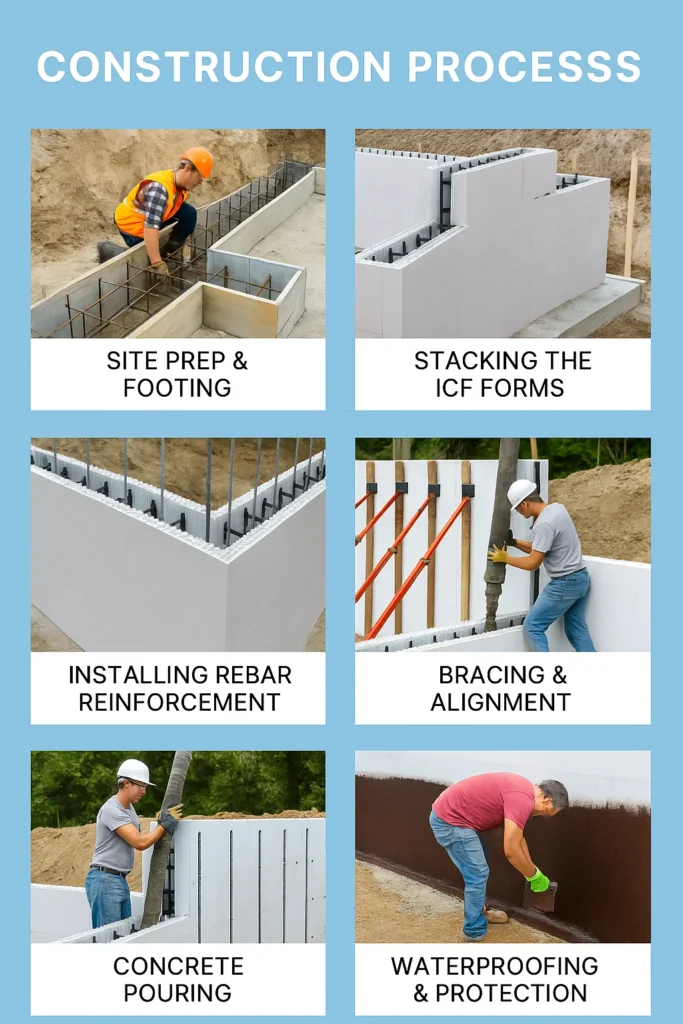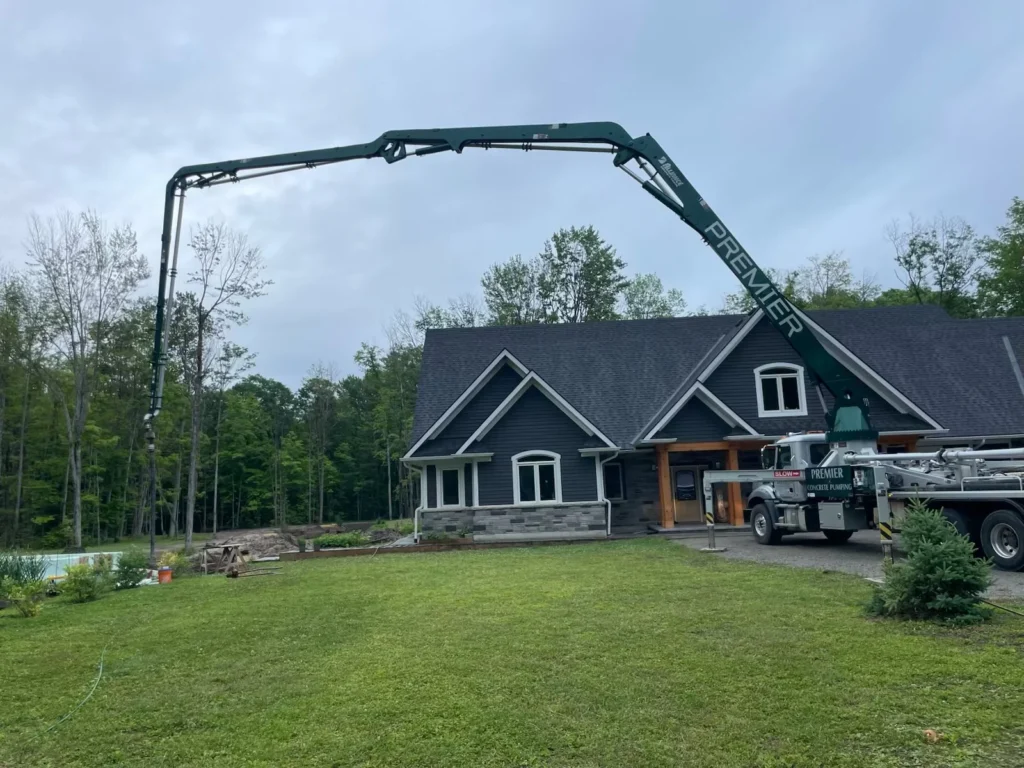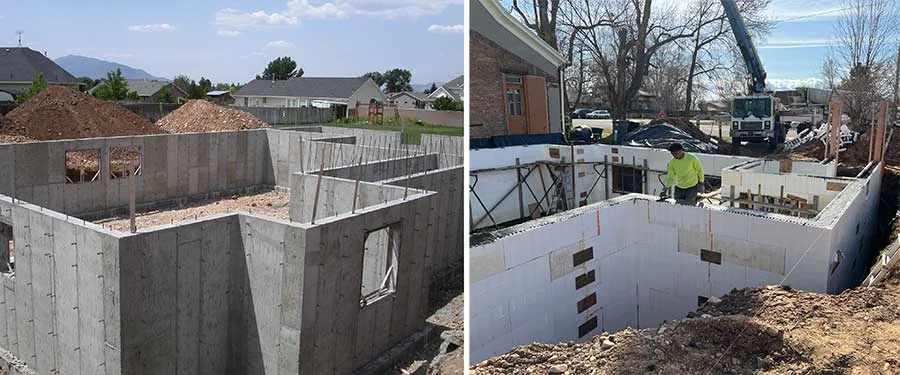An ICF (Insulated Concrete Form) foundation is a modern construction method that uses hollow foam blocks—often made of expanded polystyrene (EPS)—to act as both formwork and permanent insulation for poured concrete. These interlocking forms are stacked like LEGO blocks, filled with steel reinforcement, and then poured with concrete. Once set, the forms remain in place, offering a durable, energy-efficient wall system ideal for both below-grade and above-grade construction.
In this article, we’ll cover everything you need to know about ICF foundations—from how they work, to installation steps, pros and cons, cost comparisons, and important tips when planning your build.
Why ICFs Are Taking Over Concrete Foundations
Insulated Concrete Forms are growing in popularity for residential and commercial builds throughout Ontario and other cold-climate regions. At Premier Concrete Pumping, we’ve worked with dozens of homebuilders who exclusively use ICF for their foundations, especially in areas like Orillia, Oro-Medonte, and Tiny.
What makes ICF so appealing?
Higher strength due to consistent curing
Better insulation thanks to EPS foam
Faster installation
Minimal air leakage
Reduced thermal bridging
Less risk of cracking or shifting

The Construction Process of an ICF Foundation
Step 1: Site Prep & Footing
Like any foundation, it starts with excavation and the installation of concrete footings. These footings distribute loads and ensure the walls have a strong base.
Step 2: Stacking the ICF Forms
EPS foam blocks are interlocked and stacked like large building blocks to form the shape of the foundation walls. Some come with pre-formed 90° or 45° corners.
Step 3: Installing Rebar Reinforcement
Steel rebar is added inside the hollow cores for structural support based on engineered specifications. This reinforces the wall and allows it to meet local building codes.
Step 4: Bracing & Alignment
Before pouring, the ICF walls are braced and checked for alignment. This ensures the walls remain stable and plumb during and after the pour.
Step 5: Concrete Pouring
Concrete is poured into the ICF walls in lifts (layers). Special care is taken to avoid excessive pressure which can cause blowouts. Accessories like wall snakes or vibrators are often used to help the mix settle without air pockets. Learn about the types of pumps used for ICFs here.
Step 6: Waterproofing & Protection
After curing, a waterproofing membrane (like peel-and-stick) is added to the exterior. On the inside, drywall is often added to meet code requirements for ignition barriers.

Advantages of Building with ICF Foundations
1. Superior Strength
Because the forms stay in place and help regulate curing, ICF walls end up stronger than traditional poured concrete walls. There’s no exposure to wind or rapid moisture loss. This consistent curing reduces shrinkage cracks and structural flaws.
In fact, concrete inside ICFs can be poured even in -15°C with only the top of the forms needing insulation—a major benefit for Canadian winters.
2. High Energy Efficiency
ICFs provide continuous insulation on both sides of the concrete wall with minimal thermal bridging. Typical R-values range from R-20 to R-25, but due to reduced air leakage and the thermal mass effect, real-world performance can exceed R-40 to R-50 in some regions.
3. All-Season Builds
Unlike traditional formwork, ICF foundations can be poured in nearly any weather. In hot weather, the foam protects from rapid drying. In cold weather, it protects from freezing. That means less risk of delays and more flexibility in scheduling.
4. Noise & Moisture Resistance
ICF walls provide excellent sound dampening and reduce the risk of moisture intrusion. They’re ideal for anyone wanting a quiet, mold-resistant, and comfortable lower level.
5. Fire Resistance
ICFs have been tested under 2000°F flame conditions for up to 4 hours without structural failure. This makes them a safer choice for homeowners concerned about fire resistance.
Common Applications of ICF Foundations
Custom homes
Cottages and cabins
Pools
Basements and lower levels
Energy-efficient builds
Commercial foundations
Passive House projects
At Premier, we commonly work with builders pouring ICF walls using 20m to 40m boom pumps, depending on reach and access. Our team brings in the correct pump based on site layout and the height of the forms.

How Much Does an ICF Concrete Foundation Cost?
Compared to traditional poured concrete or CMU block walls, ICF foundations typically cost 30–40% more upfront. This is due to the cost of the EPS forms and accessories like bracing and wall ties.
However, that higher cost is offset by:
Faster installation
Reduced need for framing, vapor barrier, and insulation
Long-term energy savings
Fewer repairs from cracks or moisture intrusion
“You’re not just pouring a wall. You’re framing, insulating, and moisture-protecting it in one go.” — Premier Team
For homeowners focused on energy efficiency and durability, the upfront investment is often worth it.
Limitations and Considerations
While ICF foundations are versatile, there are some points to be aware of:
Not DIY friendly – While stacking the blocks is simple, the bracing, concrete pour, and pressure management must be handled by experienced contractors.
Interior finishing – Building code requires drywall (or equivalent) as a fire-rated ignition barrier on the interior side of any EPS foam.
Exterior waterproofing – A peel-and-stick membrane is commonly used to waterproof the exterior walls.
Design flexibility – ICFs are great for straight walls, but radius walls require special planning or prefab orders.
Planning access for pouring – Proper pump selection and setup are critical. For example, tight spaces may require a line pump, while taller walls may need a boom pump with a wall snake attachment.
Comparing ICF vs Traditional Foundation Walls
| Feature | ICF Foundation | Traditional Poured Concrete |
|---|---|---|
| Insulation | Built-in R20–R50 | Requires external insulation |
| Thermal Bridging | Minimal | High |
| Build Time | Faster (fewer steps) | Slower |
| Moisture Resistance | High | Medium to Low |
| Soundproofing | Excellent | Moderate |
| Fire Resistance | 4+ hour rating | Lower |
| Cost | 30–40% higher | Lower upfront |
| DIY Friendly? | No | No |
| Structural Strength | High | Moderate |

Common Questions About ICF Foundations
Is ICF waterproof?
Not by itself. ICF walls need a waterproof membrane applied to the exterior, such as peel-and-stick or spray-on systems.
Can I pour ICF walls in the winter?
Yes. With proper planning, concrete can be poured into ICFs even at -15°C, as long as the tops of the forms are insulated during curing.
How are plumbing and electrical installed?
Chases are cut into the EPS foam, and wires or pipes are inserted before finishing with drywall.
Do ICFs off-gas or release toxic fumes?
EPS forms are treated with flame-retardants. Studies by the National Research Council found emissions comparable to wood construction materials.
Can you build curved walls with ICF?
Yes. Radius walls can be achieved by miter cutting or ordering pre-curved ICF panels from manufacturers.
Final Thoughts: Should You Build With ICF?
ICF foundations offer a durable, energy-efficient, and comfortable lower level—far superior to the cold, damp basements many people associate with concrete foundations. With thermal stability, excellent curing conditions, and all-season build capabilities, they’re a smart solution for builders in Ontario and across Canada.
Whether you’re constructing a cottage in Muskoka or a dream home in the GTA, Premier Concrete Pumping can help you choose the right equipment, pump size, and accessories to get the job done right.
Have questions about your ICF project? Contact us today for expert advice and equipment recommendations.
